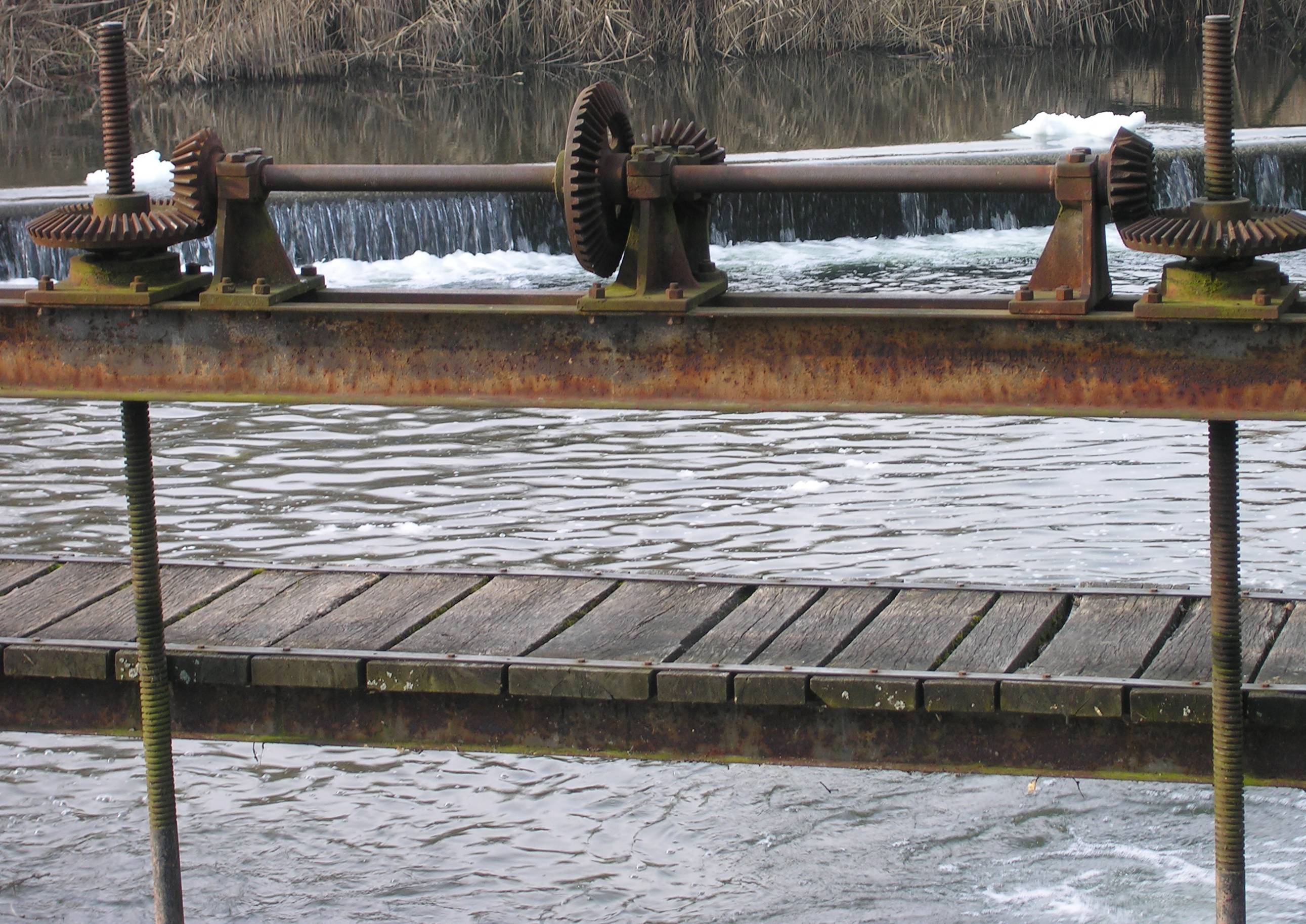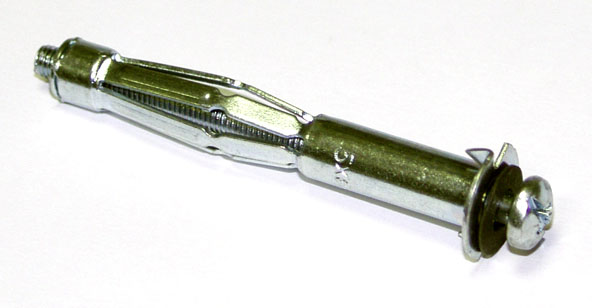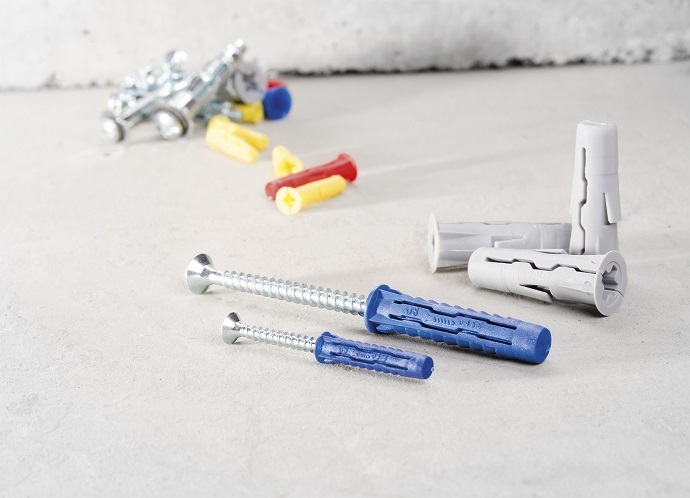|
Drywall Anchor
A drywall anchor, also known as a wall anchor, is an insert that, combined with the appropriate screw, can create a strong mount anywhere on a drywall panel or similar hollow wall. A drywall anchor goes between the screw and the drywall, gripping the drywall much more effectively than a screw would. Some have toggle arms that either drop behind the wall or expand within the cavity. Others include wide threads that carve out grooves in the wall for traction. All drywall anchors are designed to create a strong mount point by distributing the applied load over an increased surface area. Drywall anchors are used when creating a mount point that does not have a wall stud behind it. There are many types of drywall anchors. A few common ones include expandable metal anchors ( molly bolts), WallClaw anchors, toggle bolts, and self-drilling drywall anchors. See also * Toggle bolt * Molly (fastener) * Rawlplug * Wall plug A wall plug (UK English),In US English, a wall pl ... [...More Info...] [...Related Items...] OR: [Wikipedia] [Google] [Baidu] |
Screw
A screw and a bolt (see '' Differentiation between bolt and screw'' below) are similar types of fastener typically made of metal and characterized by a helical ridge, called a ''male thread'' (external thread). Screws and bolts are used to fasten materials by the engagement of the screw thread with a similar ''female thread'' (internal thread) in a matching part. Screws are often self-threading (also known as self-tapping) where the thread cuts into the material when the screw is turned, creating an internal thread that helps pull fastened materials together and prevents pull-out. There are many screws for a variety of materials; materials commonly fastened by screws include wood, sheet metal, and plastic. Explanation A screw is a combination of simple machines: it is, in essence, an inclined plane wrapped around a central shaft, but the inclined plane (thread) also comes to a sharp edge around the outside, which acts as a wedge as it pushes into the fastened material, and th ... [...More Info...] [...Related Items...] OR: [Wikipedia] [Google] [Baidu] |
Drywall
Drywall (also called plasterboard, dry lining, wallboard, sheet rock, gypsum board, buster board, custard board, and gypsum panel) is a panel made of calcium sulfate dihydrate (gypsum), with or without additives, typically extruded between thick sheets of facer and backer paper, used in the construction of interior walls and ceilings. The plaster is mixed with fiber (typically paper, glass wool, or a combination of these materials); plasticizer, foaming agent; and additives that can reduce mildew, flammability, and water absorption. In the middle of the 20th century, drywall construction became prevalent in North America as a time- and labor-saving alternative to lath and plaster. History The first plasterboard plant in the UK was opened in 1888 in Rochester, Kent. Sackett Board was invented in 1894 by Augustine Sackett and Fred Kane, graduates of Rensselaer Polytechnic Institute. It was made by layering plaster within four plies of wool felt paper. Sheets were thick with o ... [...More Info...] [...Related Items...] OR: [Wikipedia] [Google] [Baidu] |
Screw Thread
A screw thread, often shortened to thread, is a helical structure used to convert between rotational and linear movement or force. A screw thread is a ridge wrapped around a cylinder or cone in the form of a helix, with the former being called a ''straight'' thread and the latter called a ''tapered'' thread. A screw thread is the essential feature of the screw as a simple machine and also as a threaded fastener. The mechanical advantage of a screw thread depends on its ''lead'', which is the linear distance the screw travels in one revolution. In most applications, the lead of a screw thread is chosen so that friction is sufficient to prevent linear motion being converted to rotary, that is so the screw does not slip even when linear force is applied, as long as no external rotational force is present. This characteristic is essential to the vast majority of its uses. The tightening of a fastener's screw thread is comparable to driving a wedge into a gap until it sticks fast thro ... [...More Info...] [...Related Items...] OR: [Wikipedia] [Google] [Baidu] |
Wall Stud
A wall stud is a vertical repetitive framing member in a building's wall of smaller cross section than a post. It is a fundamental element in frame building. Etymology ''Stud'' is an ancient word related to similar words in Old English, Old Norse, Middle High German, and Old Teutonic generally meaning ''prop'' or ''support''."Stud". def. 1. ''Oxford English Dictionary'' Second Edition on CD-ROM (v. 4.0) © Oxford University Press 2009 Other historical words with similar meaning are ''quarter'' and ''scantling'' (one sense meaning a smaller timber, not necessarily the same use). ''Stick'' is a colloquial term for both framing lumber (timber) and a "timber tree" (a tree trunk good for using as lumber (timber)); thus, the names ''"stick and platform"'', ''"stick and frame"'', ''"stick and box"'', or simply ''stick framing''. The stud height usually determines the ceiling height, thus sayings like: "...These rooms were usually high in stud..." Purpose Studs form walls and may carry ... [...More Info...] [...Related Items...] OR: [Wikipedia] [Google] [Baidu] |
Molly (fastener)
A molly or molly bolt (often misspelled moly) is a type of screw fastener that fastens objects to plaster or gypsum board hollow walls by providing an anchor to be lodged inside a hole and expanded once in position. Larger sizes permit reasonably heavy objects, such as shelving, flatscreen-TV mounts or central-heating radiators, to be attached to drywall in locations where there is no stud behind the drywall. For heavy objects, multiple molly bolts may be required. The name Molly was formerly trademarked but is now often used in generic reference. Other names used for this same general type of fastener include hollow-wall anchor and hollow-door anchor, sometimes with design variations but always with the same design theme of expansion via deformation as the screw is tightened. The name ''drywall anchor'' sometimes is used in a way that includes both mollies and plastic deformable anchors, and sometimes it is used to contradistinguish the plastic type (wall plugs) from mollies. ... [...More Info...] [...Related Items...] OR: [Wikipedia] [Google] [Baidu] |
Toggle Bolt
A toggle bolt, also known as a butterfly anchor, is a fastener for hanging objects on hollow walls such as drywall. Toggle bolts have wings that open inside a hollow wall, bracing against it to hold the fastener securely.New Fix-it yourself manual, Reader's Digest, The wings, once fully opened, greatly expand the surface area making contact with the back of the hollow wall. This ultimately spreads out the weight of the secured item, increasing the weight that can be secured compared to a regular bolt. See also * Molly (fastener) A molly or molly bolt (often misspelled moly) is a type of screw fastener that fastens objects to plaster or gypsum board hollow walls by providing an anchor to be lodged inside a hole and expanded once in position. Larger sizes permit reasonably ... References {{Reflist Fasteners Wall anchors ... [...More Info...] [...Related Items...] OR: [Wikipedia] [Google] [Baidu] |
Bolt Molly
The BOLT Browser was a web browser for mobile phones including feature phones and smartphones that can run Java ME applications. The BOLT Browser was offered free of charge to consumers and by license to mobile network operators and handset manufacturers. BOLT was produced by Bitstream Inc., the company which previously produced ThunderHawk for mobile network operators and handset manufacturers. BOLT was originally introduced into private beta on January 15, 2009 and was made available to the public on February 16, 2009 when the public beta was announced at Mobile World Congress in Barcelona. BOLT supported Java-based handsets with Java MIDP 2 and CLDC 1.0 or higher. BOLT also has specially optimized version for BlackBerry smartphones and worked with Windows Mobile and Palm OS devices that employ a MIDlet manager or Java emulator. BOLT was built using the WebKit rendering engine to display a full Web page layout as found on desktop web browsers. In December 2011, BOLT Browser ... [...More Info...] [...Related Items...] OR: [Wikipedia] [Google] [Baidu] |
Toggle Bolts
Toggle may refer to: *Toggle mechanism * Toggle switch * Toggling harpoon, an ancient weapon and tool used in whaling to impale a whale when thrown *A type of textile closure, like an elongated button *Toggle (Doonesbury character), a character in the comic strip ''Doonesbury'' *Feature toggle, a technique in software development * Cordlock toggle, for stopping a cord or drawstring. *Toggle ropes A toggle rope was part of the standard equipment of British commandos and the Parachute Regiment during World War II. It was long, and had a toggle at one end in a tightly fitting eye splice, with a larger eye at the other end. This enabled the ..., a piece of military equipment * Toggle bolt, a type of fastener * Toggle (website), a Singaporean entertainment website and OTT service since renamed to meWATCH {{disambiguation ... [...More Info...] [...Related Items...] OR: [Wikipedia] [Google] [Baidu] |
Rawlplug
The Rawlplug Group is a company involved in the production of fixings, fasteners, and other tools. History Rawlings Brothers, a small plumbing and electrical engineering company, was founded in 1887 in London. In 1910, the company was awarded a contract by the British Museum, which required them to unobtrusively fix electrical fittings to the museum walls. The contract led to the invention and patenting of the world's first wall plug, which became a standard solution for attaching things to walls. John Joseph Rawlings, who is credited with the invention of the wall plug, named his product Rawlplug, using the first syllable of his last name, and renamed his business to Rawlplug in 1919. Products During the inter-war period, the Rawlplug company patented some new fixing methods and tools. After the war, it invented the first metal drywall anchor in 1947. ETA registration The company continued to sell its products worldwide and in 1998 became the first British producer to atta ... [...More Info...] [...Related Items...] OR: [Wikipedia] [Google] [Baidu] |
Wall Plug
A wall plug (UK English),In US English, a wall plug would likely be understood as an electric socket on a wall, although that is a misnomer as a socket is a device that accepts a plug. also known as an anchor (US) or " Rawlplug" (UK), is a fibre or plastic (originally wood) insert used to enable the attachment of a screw in material that is porous or brittle or that would otherwise not support the weight of the object attached with the screw. It is a type of anchor that, for example, allows screws to be fitted into masonry walls. In US English, mentions of drywall anchors are sometimes meant (and taken) to refer specifically to the type of plastic wall plugs with expandable wings for hollow walls, in contradistinction with mollies and toggle bolts. There are many forms of wall plug, but the most common principle is to use a tapered tube of soft material, such as plastic. This is inserted loosely into a drilled hole, then a screw is tightened into the centre. As the screw enters ... [...More Info...] [...Related Items...] OR: [Wikipedia] [Google] [Baidu] |





